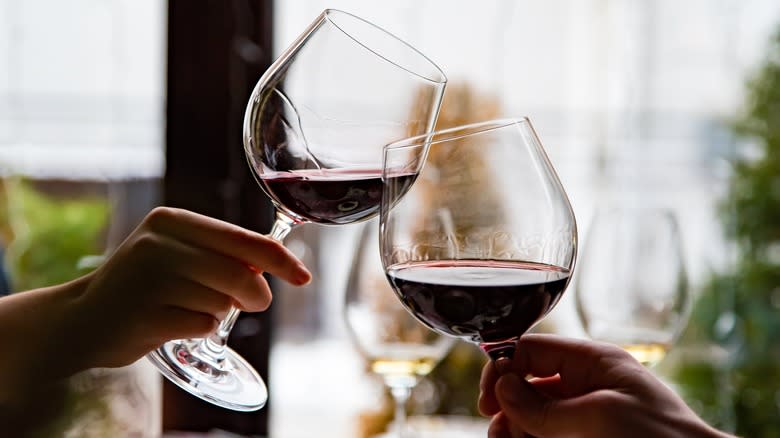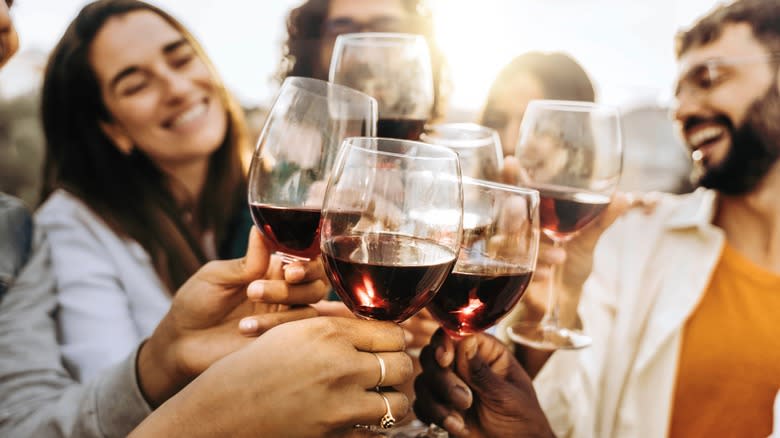The Complex History Of Non-Alcoholic Wine

- Oops!Something went wrong.Please try again later.
Consumer demand for non-alcoholic wine started sparking innovation more than a century ago. The first wine-adjacent invention was created in response to church leaders' worries about the growing alcoholism rates in the 1800s. In 1869, minister Thomas Welch developed a flash-pasteurization process that stopped grapes from fermenting, allowing churches to offer a non-alcoholic communion "wine."
Some 50 years later, German vintner Maria Jung's customers began cutting back on wine in the name of better health. Then came a way to de-alcoholize wine, the vacuum-distillation method, which was invented by Jung's son, Carl, in an attempt to help re-boost sales numbers. (This Carl Jung was not, by the way, the famous psychiatrist of the same name.) And so, the non-alcoholic wine industry was officially born. Given the recent surge in popularity for non-alcoholic wines, you might assume it was an easy ascent from Jung's early patent days when he promised all the "nature, appearance, and flavor" of regular wine in his non-alcoholic version. That's not quite what happened.
Despite attempts through the years to come up with improved de-alcoholizing processes -- including thin-film evaporation in 1975, reverse osmosis in the 1980s, and a spinning cone column method in 1991 -- non-alcoholic wine struggled with a reputation for tasting terrible. Plus, the non-drinking wellness trend that cut into Maria's sales failed to make its mark. Mixologist Derek Brown told NPR that despite 1900s bar manuals traditionally featuring non-alcoholic cocktails, "People stopped treating people who don't drink alcohol like adults." However, a new generation of sober-ish consumers are turning that tide.
Read more: Bottled Water Brands, Ranked Worst To Best
How Non-Alcoholic Wine Got Tasty

With a non-alcoholic drinks market that surpassed $11 billion in 2022, plus a trend of sober-curious drinkers driving product developers to pay closer attention to taste, it's a new day for non-alcoholic wine. Wine producers have become choosier when selecting base wines that can stand up to the high temperatures it takes to remove alcohol. They're also mastering the process of reinfusing texture and delicate flavors (by using mannoproteins and sugar in more precise doses).
The off-putting syrupy sweetness of early non-alcoholic wines has transformed into something balanced and delicious. Australian non-alcoholic wine newcomer, NON, has won over consumers by, as founder Aaron Trotman told the Robb Report, "striking a balance between the fruit, tannins, salinity, and acid found in the world's best wines."
In that way, non-alcoholic wine is beginning to deliver on Carl Jung's 1913 promise of a product that holds the essence of wine without the downside of adverse health effects. Add to that, trendy terms like "sober-curious" and "sober-ish" seem to have stuck, so winemakers can count on sales boosts even outside of campaign months like Dry January or Sober October. In fact, bars that once offered mocktails are starting to offer non-alcoholic wines, as well -- a rarity not so long ago. As a sign of the times, people find themselves researching what to expect at sober bars, which serve no alcohol at all. In this market, Maria Jung could probably hit sales targets with no problem.
Read the original article on Mashed

